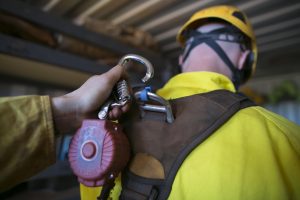Print a Sign-In Sheet | Spanish Version Coming Soon
The Occupational Safety and Health Administration (OSHA) standards on fall protection state employers must have a written fall protection program if workers are exposed to falls from heights.
The trigger height for general industry is 4 feet and 6 feet for the construction industry. OSHA standards also state the employer must provide prompt rescue of employees in the event of a fall unless the employer can ensure the employee is able to rescue himself/herself.
The American National Standards Institute (ANSI) says prompt would be making verbal or physical contact with the employee within six minutes and rescue within 15 minutes. A quick rescue is imperative to preventing/reducing injury and saving the employee’s life. Please see the information below regarding hazards associated with being arrested in a fall and items to consider in fall rescue planning.
- Fall protection methods:
- Eliminate the fall hazard first.
- Passive fall restraint.
- Guardrails.
- Safety nets.
- Active fall arrest system:
- Anchor point.
- Body harness.
- Connector/lanyard/lifeline.
- Controlled access zones.
- Hazards associated with being arrested in a fall:
- Leg circulation reduced.
- Heart circulation reduced.
- Brain circulation reduced.
- Orthostatic intolerance – occurs when the leg straps of a harness constrict the veins, causing blood to pool in the legs.
- Suspension trauma – can result in unconsciousness, followed by death in less than 30 minutes.
- Signs and symptoms of orthostatic intolerance and suspension trauma:
- Faintness.
- Breathlessness.
- Sweating.
- Increased heart rate.
- Nausea.
- Dizziness.
- Greying or loss of vision.
- Unusually low heart rate.
- Factors affecting the risk of suspension trauma:
- Fatigue.
- Hypothermia.
- Blood loss.
- Inability to move legs.
- Injuries during fall.
- Dehydration.
- Cardiovascular problems.
- Shock.
- Ways to reduce pressure and discomfort from harnesses:
- Use relief step safety straps, seat straps or pelvic straps, and foot wraps.
- Train all employees to properly wear their harness:
- D-ring between shoulder blades.
- Snug, not loose.
- What can employers do to ensure that employees are rescued promptly?
- All employees are trained on the fall rescue plan.
- Preplanning.
- Develop a fall rescue plan.
- Locate rescue equipment and have it readily available.
- Four questions of rescue planning:
- Where are workers exposed to fall hazards (do job analysis)?
- Who will be conducting the rescue operation?
- Team of other employees.
- Fire department.
- What type of equipment do we need?
- Ladders.
- Aerial lifts, forklifts.
- What rescue options do you have?
- Other questions to consider:
- What if the worker is injured?
- Qualified first-aid provider.
- Emergency services notified.
- Hospital alerted.
- How will workers call for help?
- Voice, whistle, cell phone, telephone.
- Will someone see it happen?
- Co-workers, other trades, plant personnel, public.
- What if the worker is injured?
- Fall rescue plan:
- Duties and responsibilities of the rescue team.
- Principles of safe practice.
- General guidelines on the means and methods to be employed in rescue operations.
- Training guidelines and measures of competency for rescue personnel.
- Should be specific to the jobsite and the task being performed.
- Hierarchy of fall protection rescue:
- Self-rescue.
- Assisted rescue.
- Professional rescue.
- Post-rescue treatment:
- Call 911 to alert trained/qualified emergency medical services.
- Treatment/first-aid responders.
- Reflow syndrome – toxins can build up in blood while suspended and can flow through the body.
- Never lie the person down, unless doing CPR.
- Place the individual in a seated position.
- Supplemental oxygen may be needed.
KEMI does not assume liability for the content of information contained herein. Safety and health remain your responsibility. This information is to be used for informational purposes only and not intended to be exhaustive or a substitute for proper training, supervision, or manufacturers’ instructions/recommendations. KEMI, by publication of this information, does not assume liability for damage or injury arising from reliance upon it. Compliance with this information is not a guarantee or warranty that you will be in conformity with any laws or regulations nor does it ensure the absolute safety of any person, place, or object, including, but not limited to, you, your occupation, employees, customers, or place of business.

